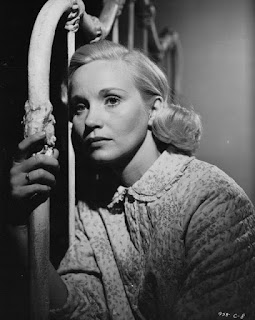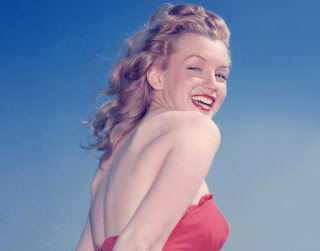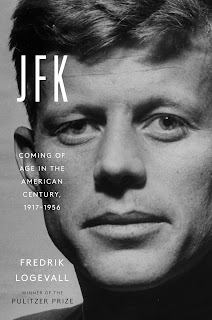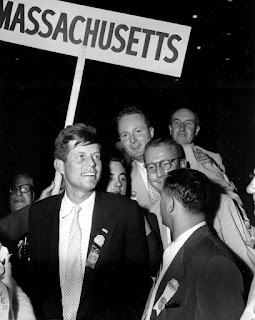Wednesday, September 23, 2020
The Great Replacement (Renaud Camus)
Tuesday, September 22, 2020
Love in the Western World, Emophilia
Sunday, September 20, 2020
The Roots of American Misery
The Roots of American Misery by James K. Galbraith:
The political scientist Robert D. Putnam has written (in collaboration with Shaylyn Romney Garrett) a sprawling account of American discontent and its evolution over the course of the past century. Their central thesis is that things got better across all measurable dimensions – economic, political, social, and cultural – from the early twentieth century until the late 1960s. But then they got worse, culminating in today’s decadence and dysfunction, so reminiscent of the Gilded Age. Putnam illustrates this grand historical sweep with a single inverted-U curve, which he calls the “I-We-I Curve.” The curve, Putnam tells us, captures the rise and fall of common purpose and collective spirit, and conversely, the fall and rise of self-absorption and narcissism – perhaps indecently reflected in our national leaders.
Saturday, September 19, 2020
JFK, The Illusion of Democracy, JFK Jr., Daryl Hannah, Carolyn Bessette
Friday, September 18, 2020
The Blackening of Europe, Male Suicide Stats
Monday, September 14, 2020
Marilyn Monroe, Madonna, JFK, JFK Jr
Saturday, September 12, 2020
The Inheritance, JFK vs. Allen Dulles
The Brilliant Disaster: JFK, Castro, and America's Doomed Invasion of Cuba's Bay of Pigs (2011) by Jim Rasenberger: A balanced, engrossing account of the Bay of Pigs crisis drawing on long-hidden CIA documents and delivering the vivid truth of five pivotal days in April 1961. JFK did not want any air strikes and he made this clear to the CIA, according to the plans he signed off in mid March. This is one reason they moved the landing site. Given that the operation's military commanders had been screened from the high level briefings that meant that JFK was not getting the full details on how exposed the landing ships were to attack. Richard Bissell had also made sure JFK and McGeorge Bundy were not told that those operational commanders had only stayed on because Bissell assured them he would obtain expanded air strikes from JFK. Although there would have been time to call off the landings, neither Bissell nor Cabell chose to talk to JFK about the issue of the last minute strike cancellation. The fact that JFK was not fully briefed on the importance of the total destruction of the Cuban Air Force nor by the initial raids failure to do so was critical. Even the JCS staff report had pointed out that risk, stating that the total success of the landings would be at risk if even a single Cuban aircraft was able to attack the supply ships. The JCS assessment also stressed the absolute necessity for a simultaneous, major Cuban resistance effort - the CIA chose not to inform JFK or his staff. JFK was also not told that mainline American Army tanks were being landed on the beach - a fact which would have overridden any concept of "deniablity" in the landings. Decades later, with access to documents, Jacob Esterline finally concluded that Bissell had made sure he was not in key meetings because his comments would likely have exposed the serious operational risks, and JFK likely would have cancelled the whole thing. Neither of the two operational commanders were in direct contact with JFK as the operation launched, if they had been issues would have come up which would likely have aborted the landings - and ended Bissell's career then and there. To sum it up, JFK refused to be blackmailed by CIA and the Joint Chiefs who set him up with false information about the Bay of Pigs. —The Brilliant Disaster: JFK, Castro, and America's Doomed Invasion of Cuba's Bay of Pigs (2011) by Jim Rasenberger
Wednesday, September 09, 2020
JFK: Coming of Age in the American Century
In the summer of 1988, JFK Jr. poured his inner anguish on his friend Sasha Chermayeff: “You know, you never get over it,” (reflecting on his father's assassination). There was an impenetrable core of John to which no tragedy, no sadness seemed to have ever broken him up. But John explained to her: “When I was growing up, I learned a person only reaches a total perspective after he's suffered. I realized I had to be broken to be whole.” When his wife Carolyn had gone several weeks without leaving their Tribeca apartment, John asked Sasha to talk with his wife. Carolyn was in bad shape when Sasha arrived. John could philosophically shrug the unrequited attention off, but Carolyn was different. He was anguished at the way she flinched under the pressure, recoiling back. On one occasion on the Cape he became so enraged at a photographer that he rushed at the man and broke his camera. “Fuck with me, but leave my wife alone!” he yelled, furious. John was so upset at the paparazzi that he talked to the district attorney’s office about getting them out of there, but that was legally impossible. Jackie had visited Istanbul, Turkey in 1985 and had told John that if he ever married, it was an ideal place to honeymoon. Traveling as “Mr. and Mrs. Hyannis,” Mr. and Mrs. John F. Kennedy Jr. arrived in Istanbul and checked into their penthouse suite atop the five-star Ciragan Palace Hotel, a former palazzo on the shores of the Bosporus.
Despite her commitment to psychological therapy, Carolyn hadn’t yet become immune to the constant scrutiny exerted by the press, a process that obviously took time. “Carolyn used to hang out at her sister Lauren’s house in Tribeca and complain about the invasion of her privacy,” said mutual friend William Peter Owen. “She’d stay until late some nights. John would return to 20 North Moore Street, and she wouldn’t be there for him. This happened on several occasions. Carolyn feared he might abandon his magazine and enter politics overnight. As I understood it, he planned on a political career, and she intended to support him. She'd had a similar block against having children. I’d say that had they lived the next year or two, she’d have been both a mother and the wife of a senator.” Another charge levied against Carolyn by author Edward Klein in The Kennedy Curse, was cocaine use. The stories that periodically had surfaced—and later in Klein’s book—were, according to Littell, “wildly exaggerated. Carolyn may have done an occasional line of cocaine, but I saw no evidence that she had an addiction. I never saw her intoxicated from alcohol or incapacitated from drugs, and I’m certain John would have told me if there had been a problem, or if she’d done hard drugs like heroin or crack.” None of John’s other friends, including Richard Wiese, Chris Overbeck, John Hare, or John Perry Barlow, ever encountered Carolyn on a drug binge. Carole Radziwill, one of Carolyn’s closest companions, dismissed Edward Klein’s “unscrupulous” conjectures as “sheer nonsense.” Carole wondered: “Who is this group of anonymous friends of John and Carolyn’s who were so helpful in writing Klein’s book? No one in the Bessette or Kennedy family spoke to him, and I have spoken to many of Carolyn’s closest friends—none of us were asked to cooperate. Klein’s assertion of ‘hard drug’ abuse on Carolyn’s part is ludicrous. In the ten years that I knew Carolyn, I never once saw her use drugs. She was as much a ‘cokehead’ as Klein is a biographer. Some columns whispered they weren’t having sex any longer; that was the most ridiculous part, since no matter how their fights began, they ended in only one way. ”
Caroline Kennedy proved herself to be influential in rousing his brother's desire to eventually enter the political arena. In private John told friends and colleagues that the prospect interested him, that sooner or later he intended to make the transition from magazine editor to political candidate. Carolyn Maloney, New York Democratic congresswoman for the 14th District, heard that when John learned of Hillary Clinton’s interest in entering the senatorial race in New York in 2000, he polled for Maloney’s seat. He considered several other possibilities as well, among them the race for governor of New York. When Ted Kennedy suggested he consider running for office in Rhode Island, John responded, “That’ll put me in the same boat as Hillary—I’ll be regarded as a carpetbagger.” “Don’t be silly,” said Ted Kennedy. “Bobby was accused of being a carpetbagger when he ran for the Senate in New York in the mid-1960s. It didn’t stop him from winning.” John obviously also feared he would end up like his uncle Bobby if he ran for the Senate. On April 22 1998, John fulfilled the requirements for a private pilot’s license and purchased his first plane, the Cessna 182. Caroline Kennedy warned his brother by insisting that he took flights with extreme caution. “After all,” a family friend overheard Caroline say to him, “you’re no longer alone—you have a wife to worry about.” Caroline recognized that his brother was crazy about Carolyn. “‘Whenever she’s around,’ said once Caroline, ‘he’s got that goofy, fool-in-love expression on his face.’” —The Day John Died (2007) by Christopher Andersen































































